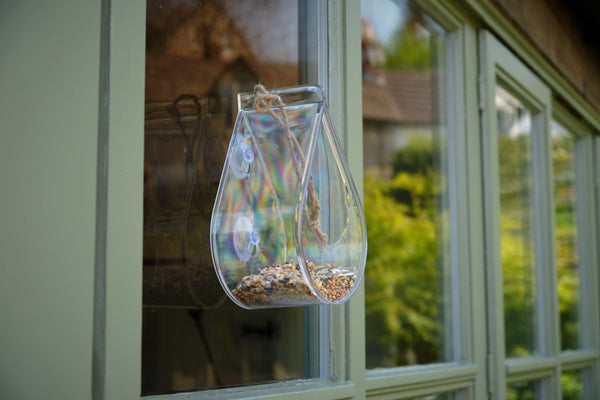UK Birds Beginning with B
When it comes to the diverse world of birds, those whose names start with the letter "B" boast a captivating array of species.
Each bird brings its unique charm to the skies. Join us on our A-Z bird naming journey as we explore some notable avian inhabitants whose names are birds that start with the letter "B."
Birds that start with b
Blackbird
The Blackbird (Turdus merula), with its glossy black plumage and bright yellow-orange beak, is a familiar sight in gardens across the UK, in fact, it's one of the most common birds in the country. You'll find them across a whole range of habitats including Woodland, Urban and Suburban, Farmland, Grassland.
Renowned for its melodious song, these birds are not only a visual delight but also a charming presence in our everyday lives.
Blue Tit
The Blue Tit (Cyanistes caeruleus), with its vibrant green, blue and yellow plumage, is a small yet lively bird commonly found in woodlands and gardens.
During the winter season, familial flocks of Blue Tits unite with other tit species in their quest for food. If you observe four or five Blue Tits at a feeder in your garden simultaneously, it's likely that they are part of a larger group, with the collective number potentially exceeding 20 individuals.
Their acrobatic antics and distinctive call make them a joy to observe, adding a burst of colour to the natural surroundings.

Bullfinch
The Bullfinch (Pyrrhula pyrrhula), is a symbol of elegance in the avian world.
Distinguished by a vibrant pink breast and neck set against a sleek black cap, the male Bullfinch makes a striking visual statement. While the females exhibit a more subdued coloration, they remain captivating birds.
Bullfinches frequently make appearances at garden bird feeders, and during spring, they gracefully visit fruit trees in gardens to delicately consume buds and seeds. Listen for their gentle, single-whistle call, adding to the charm of their presence.
Often seen in woodlands and orchards, these birds bring a touch of charm to the British countryside.

Buzzard
Look to the skies, and you might catch sight of the Buzzard (Buteo buteo), a majestic bird of prey with a wingspan that commands attention. These raptors are not only visually imposing but are also instrumental in the delicate dance of nature.
Known for their magnificent wings, effortless soaring, and keen eyesight, Buzzards play a vital role in maintaining the ecological balance. Their expansive wings, spanning up to 4 feet, allow them to navigate the currents of the air with remarkable ease. This aerial prowess is not merely for show; it serves a crucial purpose in their role as skilled hunters.
Buzzards are opportunistic predators, preying on small mammals, birds, and carrion. From their vantage point high in the sky, their sharp eyesight enables them to spot potential prey on the ground with remarkable precision. This keen vision, coupled with their soaring flights, makes them efficient hunters and helps regulate the population of smaller animals in their habitats.
Barn Owl
The Barn Owl (Tyto alba), with its heart-shaped face and ghostly appearance, is a nocturnal hunter that frequents farmlands and open fields. These enigmatic birds are not only visually captivating but also exhibit fascinating adaptations that contribute to their success as nighttime predators.
Silent in flight, Barn Owls possess specialised feathers that minimise sound, allowing them to approach their prey with near-silent stealth. Their wings are designed in a way that reduces turbulence, minimising the noise usually associated with other bird species. This unique feature makes them expert hunters, enabling them to swoop down on unsuspecting rodents and small mammals without alerting them to their presence.
The keen hunting abilities of Barn Owls are further enhanced by their exceptional hearing. Their heart-shaped facial disc functions like a satellite dish, capturing and funneling sound to their highly developed ears. This acute sense of hearing allows them to locate prey, even in complete darkness, making them formidable hunters of the night.

Blackcap
The Blackcap (Sylvia atricapilla), with its distinctive black cap (as the name suggests), is a delightful warbler commonly found in woodlands and gardens. These charming birds bring more than just visual appeal to their habitats; they contribute a captivating auditory experience to the natural world.
Renowned for their sweet, melodious song, Blackcaps create a soothing soundtrack that resonates through woodlands and gardens. Their intricate melodies, composed of a variety of trills, warbles, and fluty notes, are a testament to the bird's vocal prowess. During the breeding season, male Blackcaps particularly engage in complex singing, using their songs to establish territories and attract mates.
Interestingly, Blackcaps are known for their ability to mimic the songs of other bird species. This mimicry adds a layer of complexity to their vocalisations and may serve multiple purposes, from communication to confusing potential predators.
Brambling:
As winter approaches, keep an eye out for the Brambling (Fringilla montifringilla), a migratory bird with striking orange and black markings. These winter visitors, embarking on long journeys from their breeding grounds in northern Europe and Asia, grace the UK with their vibrant presence during the colder months.
Bramblings, resembling a more colourful counterpart to the Chaffinch, exhibit distinctive plumage that sets them apart. The males boast a fiery orange breast and shoulders, complemented by striking black markings on their head, chest and neck. Females and non-breeding males, while more subtly adorned, still showcase a charming combination of warm hues.
Arriving in flocks, Bramblings bring a burst of color to the UK's winter landscape, creating a lively spectacle for avid birdwatchers. Their vibrant plumage, amidst the more subdued winter tones, adds a touch of warmth and brilliance to the natural surroundings.

Black-headed Gull
The Black-headed Gull (Chroicocephalus ridibundus), with its chocolate-brown to black head, during the breeding season, is a common sight along coastal areas and inland waters. These adaptable gulls demonstrate a remarkable ability to thrive in diverse environments, from bustling seaside locales to serene inland lakes.
Renowned for their aerial acrobatics, these gulls add a dynamic element to the marine landscape. Their agile flight patterns include graceful dives and impressive hovering displays as they skillfully navigate the coastal winds. In addition to their aerobatic prowess, Black-headed Gulls are social birds, often seen in large, chattering flocks that contribute to the lively atmosphere of the coastal scenery.
During the breeding season, the chocolate-brown hue of their heads becomes a distinctive feature of adult males, creating a visually striking contrast with their white plumage. As opportunistic feeders, Black-headed Gulls play a vital role in marine ecosystems by scavenging for a variety of prey, including fish, insects, and even scraps from human activities along the shores.
Bittern
The Bittern(Botaurus stellaris), with its cryptic plumage that effortlessly blends with the dense reed beds, showcases remarkable mastery in navigating wetland environments.
Sporting intricate patterns that mimic the surrounding vegetation, these birds seamlessly camouflage themselves, making them particularly challenging to spot. As they navigate through the marshlands, their elusive presence contributes to an air of mystery, creating an enchanting atmosphere in the wetland habitats they call home.
Bitterns are known for their ability to remain concealed, utilising their superb adaptation to the surroundings, allowing lucky observers a rare glimpse into the dark, hidden world of wetland wildlife.

Baltimore Oriole
The Baltimore Oriole, with its vibrant orange and black plumage, is a delight to birdwatchers. These songbirds, known for their sweet melodies, add a splash of colour to the treetops.
As you embark on your birdwatching adventures in the UK, keep an eye out for these remarkable birds beginning with "B." Each species contributes to the rich tapestry of British wildlife, reminding us of the diversity and beauty that can be found in our natural surroundings.
Blue Jay
Another honorary mention goes to the Blue Jay, a bird not native to the UK but celebrated for its striking blue plumage and lively presence in other regions.
Originally hailing from North America, the Blue Jay has expanded its range, captivating bird enthusiasts with its brilliant azure feathers and characteristic crested head. Their bold colors, marked by vibrant blues, whites, and blacks, create a captivating spectacle against various landscapes.
Accompanying their eye-catching appearance is a repertoire of distinctive calls, ranging from sharp jeers to melodic notes, adding an auditory dimension to their charm.
Although they may not grace the British skies naturally, the Blue Jay's vivid hues and animated behaviours make them a fascinating addition to any birdwatcher's list, offering a unique glimpse into the avian diversity found beyond UK borders.
As you embark on your birdwatching adventures in the UK, keep an eye out for these remarkable "B" birds. Each species, whether a resident or a visitor, contributes to the captivating biodiversity of British wildlife. In the intricate world of feathers and song, these birds remind us of the beauty that surrounds us and the importance of preserving birds starting their habitats.











